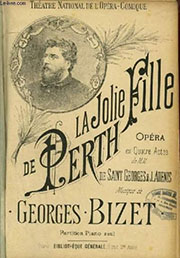“La Jolie Fille de Perth” has been published by Fishergate Music as volume 3 of the series “Bizet's Other Operas”. The editor is Hugh Macdonald. Like “Carmen” and “Les Pêcheurs de perles”, the opera is full of brilliance and ingenuity. This new edition of “La Jolie” has removed all later additions, thus offering a reliable basis for performances.
Fishergate Music is proud to announce the publication of “La Jolie Fille de Perth” as Volume 3 of its series “Bizet’s Other Operas“, edited by Hugh Macdonald. Along with “Carmen” and “Les Pêcheurs de perles”, this four-act opera is full of the brilliance and sparkling invention that were Bizet’s stock-in-trade, and although it was frequently performed at the end of the nineteenth century, it has not, since that time, had the attention it deserves. This may be because all available editions of the opera have, until now, presented various corrupt versions of the opera adjusted by unknown hands after Bizet’s early death. The new edition is based entirely on two authentic sources: Bizet’s autograph manuscript, held by the Bibliothèque nationale de France in Paris, and the vocal score published within a month of the opera’s first performance in December 1867.
The opera was composed in 1866 in response to a commission from the Théâtre-Lyrique, which had staged “Les Pêcheurs de perles” three years before. It was conceived with the Swedish coloratura soprano Christine Nilsson in mind, although by the time the opera was performed she was no longer available. Her replacement, Jeanne Devriès, delighted Bizet in the role of Catherine Glover, however. The opera is very loosely based on Walter Scott’s “The Fair Maid of Perth”, although Bizet made no attempt to give it a Scottish tone. The libretto introduced a new character, Mab, instead. She is a gypsy, like Carmen, who leads the well-known “Danse bohémienne” in Act II.
Other memorable movements are the duet for Mab and the Duc de Rothsay in Act III, cleverly exchanged on stage while the music better known as the Menuet from the “Arlésienne Suite” no. 2 (although it has nothing to do with the Arlésienne music) is heard in the distance. There are some more great duets in “La Jolie Fille de Perth”: for the lovers Smith and Catherine in Act I and Act IV, and for Smith and the bass Ralph in Act IV. The March for the town guard in Act II has Bizet’s inimitable stamp, and the magical Serenade that Smith sings in Act II, retrieved from his earlier opera Don Procopio, has always been a favourite of the tenor repertory.
There is not a dull moment in this opera, and the chorus have some stirring moments. They are workmen in Smith’s forge, in Act I, privileged gentry playing cards with the Duke in Act III, and vociferous citizens of Perth at other times. Mistaken identity creates confusion and rivalry, although the truth emerges in time for a happy ending for all.
Hugh Macdonald
(December 2022)



